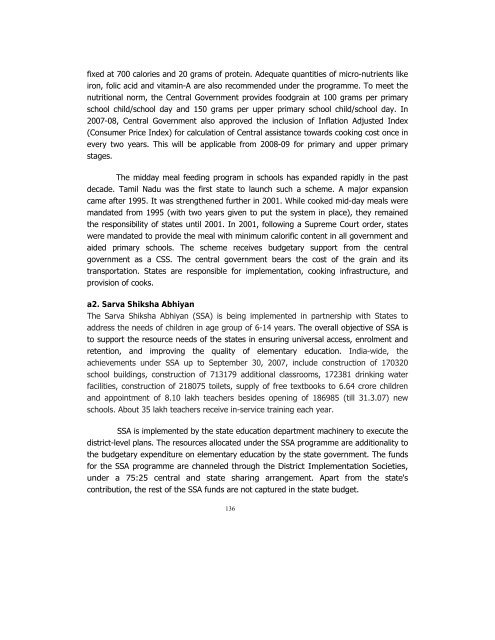POVERTY REDUCTION STRATEGY TN
You also want an ePaper? Increase the reach of your titles
YUMPU automatically turns print PDFs into web optimized ePapers that Google loves.
fixed at 700 calories and 20 grams of protein. Adequate quantities of micro-nutrients like<br />
iron, folic acid and vitamin-A are also recommended under the programme. To meet the<br />
nutritional norm, the Central Government provides foodgrain at 100 grams per primary<br />
school child/school day and 150 grams per upper primary school child/school day. In<br />
2007-08, Central Government also approved the inclusion of Inflation Adjusted Index<br />
(Consumer Price Index) for calculation of Central assistance towards cooking cost once in<br />
every two years. This will be applicable from 2008-09 for primary and upper primary<br />
stages.<br />
The midday meal feeding program in schools has expanded rapidly in the past<br />
decade. Tamil Nadu was the first state to launch such a scheme. A major expansion<br />
came after 1995. It was strengthened further in 2001. While cooked mid-day meals were<br />
mandated from 1995 (with two years given to put the system in place), they remained<br />
the responsibility of states until 2001. In 2001, following a Supreme Court order, states<br />
were mandated to provide the meal with minimum calorific content in all government and<br />
aided primary schools. The scheme receives budgetary support from the central<br />
government as a CSS. The central government bears the cost of the grain and its<br />
transportation. States are responsible for implementation, cooking infrastructure, and<br />
provision of cooks.<br />
a2. Sarva Shiksha Abhiyan<br />
The Sarva Shiksha Abhiyan (SSA) is being implemented in partnership with States to<br />
address the needs of children in age group of 6-14 years. The overall objective of SSA is<br />
to support the resource needs of the states in ensuring universal access, enrolment and<br />
retention, and improving the quality of elementary education. India-wide, the<br />
achievements under SSA up to September 30, 2007, include construction of 170320<br />
school buildings, construction of 713179 additional classrooms, 172381 drinking water<br />
facilities, construction of 218075 toilets, supply of free textbooks to 6.64 crore children<br />
and appointment of 8.10 lakh teachers besides opening of 186985 (till 31.3.07) new<br />
schools. About 35 lakh teachers receive in-service training each year.<br />
SSA is implemented by the state education department machinery to execute the<br />
district-level plans. The resources allocated under the SSA programme are additionality to<br />
the budgetary expenditure on elementary education by the state government. The funds<br />
for the SSA programme are channeled through the District Implementation Societies,<br />
under a 75:25 central and state sharing arrangement. Apart from the state's<br />
contribution, the rest of the SSA funds are not captured in the state budget.<br />
136

















